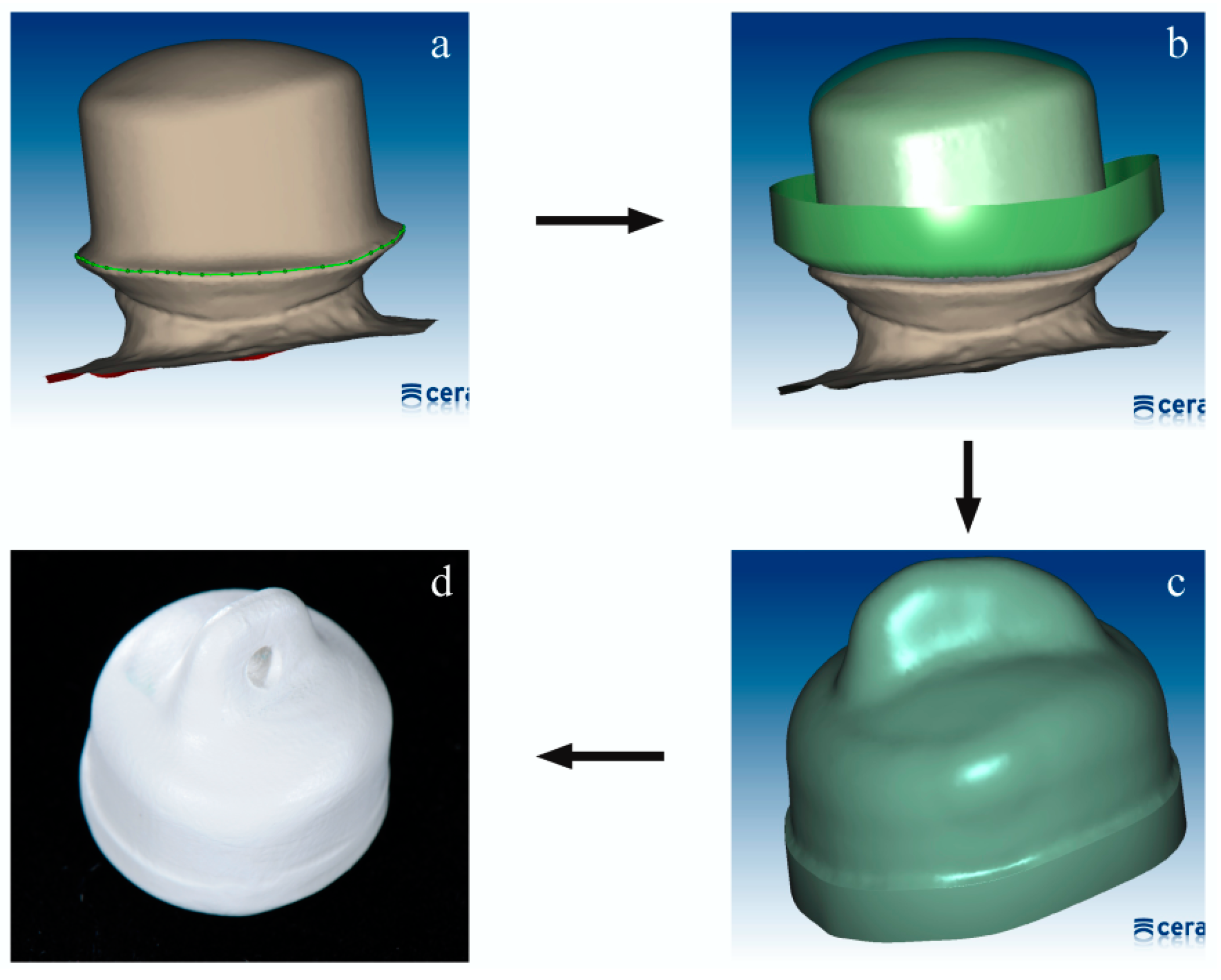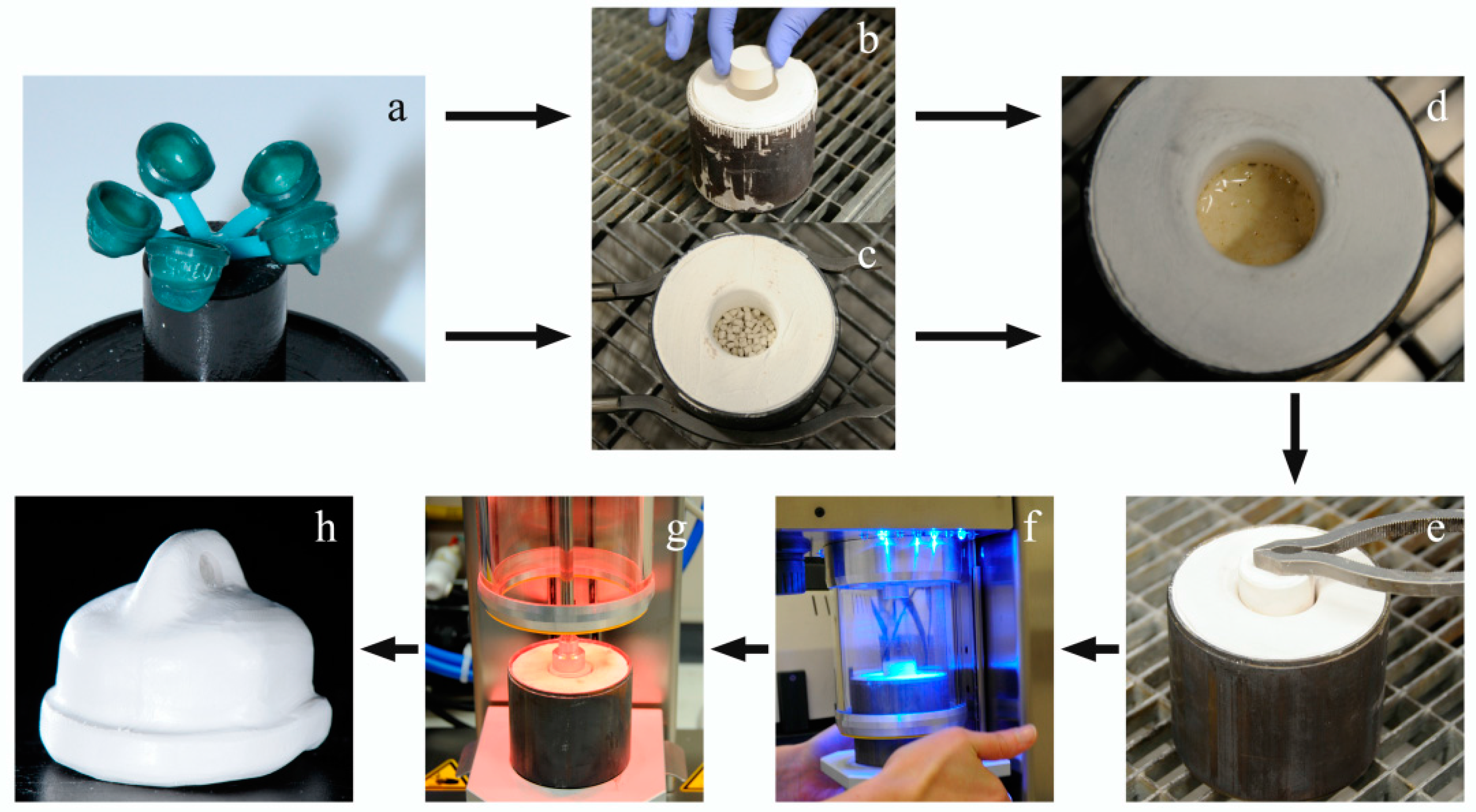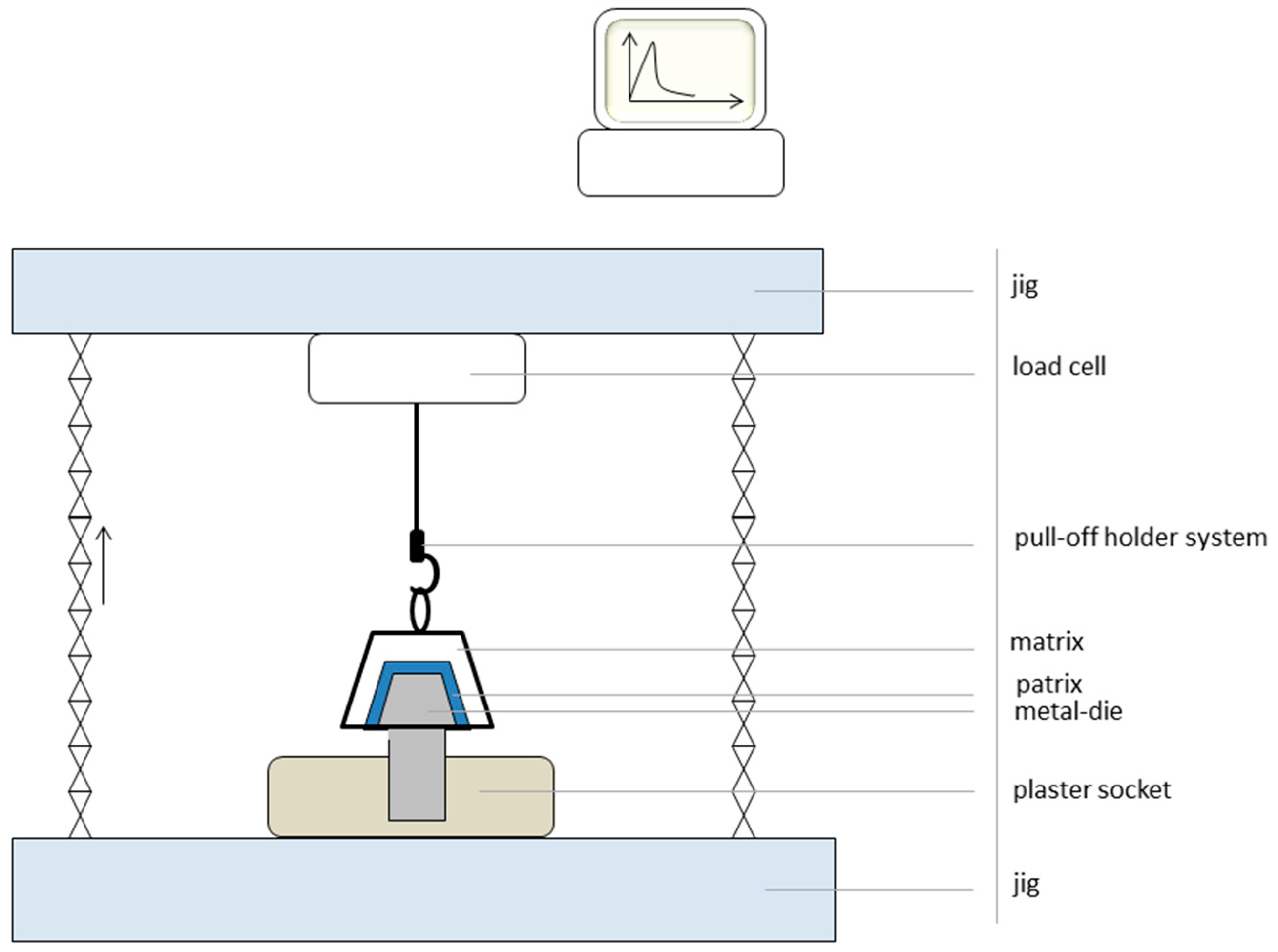Suitability of Secondary PEEK Telescopic Crowns on Zirconia Primary Crowns: The Influence of Fabrication Method and Taper
Abstract
:1. Introduction
2. Material and Methods
2.1. Fabrication of Specimens
2.2. Retention Load Measurement
2.3. Statistical Analyses
3. Results
4. Discussion
5. Conclusions
Acknowledgments
Author Contributions
Conflicts of Interest
Abbreviations
| PEEK | polyetheretherketone |
| PEAK | polyetherarylketone |
| CAD/CAM | computer-aided design/computer-aided manufacturing |
| RL | retention load |
| ZrO2 | zirconia |
| MMA | methyl methacrylate |
| FDPs | fixed dental prostheses |
| Al2O3 | aluminum oxide |
References
- Wataha, J.C. Alloys for prosthodontic restorations. J. Prosthet. Dent. 2002, 4, 351–363. [Google Scholar] [CrossRef]
- Lucas, L.C.; Lemons, J.E. Biodegradation of restorative metallic systems. Adv. Dent. Res. 1992, 6, 32–37. [Google Scholar] [PubMed]
- Cortada, M.; Giner, L.L.; Costa, S.; Gil, F.J.; Rodriguez, D.; Planell, J.A. Galvanic corrosion behavior of titanium implants coupled to dental alloys. J. Mater. Sci. Mater. Med. 2002, 5, 287–293. [Google Scholar]
- Möller, B.; Terheyden, H.; Açil, Y.; Purcz, N.M.; Hertrampf, K.; Tabakov, A.; Behrens, E.; Wiltfang, J. A comparison of biocompatibility and osseointegration of ceramic and titanium implants: An in vivo and in vitro study. Int. J. Oral Maxillofac. Surg. 2012, 5, 638–645. [Google Scholar] [CrossRef] [PubMed]
- Venugopalan, R.; Lucas, L.C. Evaluation of restorative and implant alloys galvanically coupled to titanium. Dent. Mater. 1998, 3, 165–172. [Google Scholar] [CrossRef]
- Holland, R.I.; Jorgensen, R.B.; Hero, H. Corrosion and structure of a low-gold dental alloy. Dent. Mater. 1986, 4, 143–146. [Google Scholar] [CrossRef]
- Foti, B.; Tavitian, P.; Tosello, A.; Bonfil, J.J.; Franquin, J.C. Polymetallism and osseointegration in oral implantology: Pilot study on primate. J. Oral Rehabil. 1999, 6, 495–502. [Google Scholar] [CrossRef]
- Manicone, P.F.; Rossi Iommetti, P.; Raffaelli, L. An overview of zirconia ceramics: Basic properties and clinical applications. J. Dent. 2007, 11, 819–826. [Google Scholar] [CrossRef] [PubMed]
- Grösser, J.; Sachs, C.; Stadelmann, M.; Schweiger, J.; Güthe, J.F.; Beuer, F. Computer-aided fabrication of a zirconia 14-unit removable dental prosthesis: A technical report. Int. J. Comput. Dent. 2014, 4, 307–316. [Google Scholar]
- Sax, C.; Hämmerle, C.; Sailer, I. 10-year clinical outcomes of fixed dental prostheses with zirconia frameworks. Int. J. Comput. Dent. 2011, 3, 183–202. [Google Scholar]
- Beuer, F.; Edelhoff, D.; Gernet, W.; Naumann, M. Parameters affecting retentive force of electroformed double-crown systems. Clin. Oral Investig. 2010, 2, 129–135. [Google Scholar] [CrossRef] [PubMed]
- Turp, I.; Bozdağ, E.; Sünbüloğlu, E.; Kahruman, C.; Yusufoğlu, I.; Bayraktar, G. Retention and surface changes of zirconia primary crowns with secondary crowns of different materials. Clin. Oral Investig. 2014, 8, 2023–2035. [Google Scholar] [CrossRef] [PubMed]
- Becker, H. Der Einfluss von Zahnpasta auf das Haftverhalten parallelwandiger Teleskopkronen. Zahnärztliche Praxis 1983, 8, 332–334. [Google Scholar]
- Hahnel, S.; Wieser, A.; Lang, R.; Rosentritt, M. Biofilm formation on the surface of modern implant abutment materials. Clin. Oral Implants Res. 2015, 11, 1297–1301. [Google Scholar] [CrossRef] [PubMed]
- Kurtz, S.M.; Devine, J.N. PEEK biomaterials in trauma, orthopedic, and spinal implants. Biomaterials 2007, 32, 4845–4869. [Google Scholar] [CrossRef] [PubMed]
- Wimmer, T.; Huffmann, A.M.S.; Eichberger, M.; Schmidlin, P.R.; Stawarczyk, B. Two-body wear rate of PEEK, CAD/CAM resin composite and PMMA: Effect of specimen geometries, antagonist materials and test set-up configuration. Dent. Mater. 2016, 6, e127–e136. [Google Scholar] [CrossRef] [PubMed]
- Liebermann, A.; Wimmer, T.; Schmidlin, P.R.; Scherer, H.; Löffler, P.; Roos, M.; Stawarczyk, B. Physicomechanical characterization of polyetheretherketone and current esthetic dental CAD/CAM polymers after aging in different storage media. J. Prosthet. Dent. 2016, 3, 321–328. [Google Scholar] [CrossRef] [PubMed]
- Schwitalla, A.D.; Abou-Emara, M.; Spintig, T.; Lackmann, J.; Müller, W.D. Finite element analysis of the biomechanical effects of PEEK dental implants on the peri-implant bone. J. Biomech. 2015, 48, 1–7. [Google Scholar] [CrossRef] [PubMed]
- Santing, H.J.; Meijer, H.J.; Raghoebar, G.M.; Ozcan, M. Fracture strength and failure mode of maxillary implant supported provisional single crowns: A comparison of composite resin crowns fabricated directly over PEEK abutments and solid titanium abutments. Clin. Implant Dent. Relat. Res. 2012, 6, 882–889. [Google Scholar] [CrossRef] [PubMed]
- Stawarczyk, B.; Eichberger, M.; Uhrenbacher, J.; Wimmer, T.; Edelhoff, D.; Schmidlin, P.R. Three-unit reinforced polyetheretherketone composite FDPs: Influence of fabrication method on load-bearing capacity and failure types. Dent. Mater. J. 2015, 1, 7–12. [Google Scholar] [CrossRef] [PubMed]
- Keul, C.; Liebermann, A.; Schmidlin, P.R.; Roos, M.; Sener, B.; Stawarczyk, B. Influence of PEEK surface modification on surface properties and bond strength to veneering resin composites. J. Adhes. Dent. 2014, 4, 383–392. [Google Scholar]
- Stawarczyk, B.; Beuer, F.; Wimmer, T.; Jahn, D.; Sener, B.; Roos, M.; Schmidlin, P.R. Polyetheretherketone—A suitable material for fixed dental prostheses? J. Biomed. Mater. Res. B Appl. Biomater. 2013, 7, 1209–1216. [Google Scholar] [CrossRef] [PubMed]
- Tannous, F.; Steiner, M.; Shahin, R.; Kern, M. Retentive forces and fatigue resistance of thermoplastic resin clasps. Dent. Mater. 2012, 28, 273–278. [Google Scholar] [CrossRef] [PubMed]
- Bayer, S.; Komor, N.; Kramer, A.; Albrecht, D.; Mericske-Stern, R.; Enkling, N. Retention force of plastic clips on implant bars: A randomized controlled trial. Clin. Oral Implants Res. 2012, 12, 1377–1384. [Google Scholar] [CrossRef] [PubMed]
- Stock, V.; Wagner, C.; Merk, S.; Roos, M.; Schmidlin, P.R.; Eichberger, M.; Stawarczyk, B. Retention force of differently fabricated telescopic PEEK crowns with different tapers. Dent. Mater. J. 2015, 4, 594–600. [Google Scholar] [CrossRef] [PubMed]
- Wagner, C.; Stock, V.; Merk, S.; Schmidlin, P.R.; Roos, M.; Eichberger, M.; Stawarczyk, B. Retention load of telescopic crowns with different taper angles between cobalt-chromium and polyetheretherketone made with three different manufacturing processes examined by pull-off test. J. Prosthodont. 2016. [Google Scholar] [CrossRef] [PubMed]
- Stock, V.; Schmidlin, P.R.; Merk, S.; Wagner, C.; Roos, M.; Eichberger, M.; Stawarczyk, B. PEEK primary crowns with cobalt-chromium, zirconia and galvanic secondary crowns with different tapers—A comparison of retention forces. Materials 2016, 3. [Google Scholar] [CrossRef]
- Wagner, C.; Stock, V.; Merk, S.; Schmidlin, P.R.; Roos, M.; Eichberger, M.; Stawarczyk, B. Comparison of retention forces of different fabrication methods of Co-Cr crowns: Presintered and milled, cast and electroforming secondary crowns with different taper angles. Int. J. Dent. Oral Sci. 2015, 3, 15–20. [Google Scholar]
- Merk, S.; Wagner, C.; Stock, V.; Schmidlin, P.R.; Roos, M.; Eichberger, M.; Stawarczyk, B. Retention load values of telescopic crowns made of Y-TZP and CoCr with Y-TZP secondary crowns: Impact of different taper angles. Materials 2016, 5. [Google Scholar] [CrossRef]
- Ohkawa, S.; Okane, H.; Nagasawa, T.; Tsuru, H. Changes in retention of various telescope crown assemblies over long-term use. J. Prosthet. Dent. 1990, 2, 153–158. [Google Scholar] [CrossRef]



| Taper Angle | Material Group | Mean ± SD | 95% CI | Min/Median/Max |
|---|---|---|---|---|
| 0° | PM | 13.83 ± 7.82 ab/A | (8.1; 19.5) | 2.8/13.0/28.0 |
| PP | 22.83 ± 5.94 a/B | (18.4; 27.1) | 16.9/21.4/33.1 | |
| PG | 15.87 ± 2.58 a/A | (13.9; 17.8) | 12.5/15.8/20.2 | |
| 1° | PM | 6.07 ± 3.01 a/A | (3.8; 8.3) | 1.7/6.8/9.6 |
| PP | 21.06 ± 8.60 a/B | (14.8; 27.3) | 11.2/21.9/31.7 | |
| PG | 27.00 ± 10.05 b/B | (19.7; 34.2) | 11.3/26.9/46.5 | |
| 2° | PM | 14.10 ± 8.19 b/A | (8.1; 20.0) | 7.2/11.2/34.7 |
| PP | 19.84 ± 7.13 a/A | (14.6; 25.0) | 9.6/18.8/29.4 | |
| PG | 19.05 ± 8.25 ab/A | (13.1; 25.0) | 5.3/18.4/31.9 |
© 2016 by the authors; licensee MDPI, Basel, Switzerland. This article is an open access article distributed under the terms and conditions of the Creative Commons Attribution (CC-BY) license (http://creativecommons.org/licenses/by/4.0/).
Share and Cite
Merk, S.; Wagner, C.; Stock, V.; Eichberger, M.; Schmidlin, P.R.; Roos, M.; Stawarczyk, B. Suitability of Secondary PEEK Telescopic Crowns on Zirconia Primary Crowns: The Influence of Fabrication Method and Taper. Materials 2016, 9, 908. https://doi.org/10.3390/ma9110908
Merk S, Wagner C, Stock V, Eichberger M, Schmidlin PR, Roos M, Stawarczyk B. Suitability of Secondary PEEK Telescopic Crowns on Zirconia Primary Crowns: The Influence of Fabrication Method and Taper. Materials. 2016; 9(11):908. https://doi.org/10.3390/ma9110908
Chicago/Turabian StyleMerk, Susanne, Christina Wagner, Veronika Stock, Marlis Eichberger, Patrick R. Schmidlin, Malgorzata Roos, and Bogna Stawarczyk. 2016. "Suitability of Secondary PEEK Telescopic Crowns on Zirconia Primary Crowns: The Influence of Fabrication Method and Taper" Materials 9, no. 11: 908. https://doi.org/10.3390/ma9110908
APA StyleMerk, S., Wagner, C., Stock, V., Eichberger, M., Schmidlin, P. R., Roos, M., & Stawarczyk, B. (2016). Suitability of Secondary PEEK Telescopic Crowns on Zirconia Primary Crowns: The Influence of Fabrication Method and Taper. Materials, 9(11), 908. https://doi.org/10.3390/ma9110908








